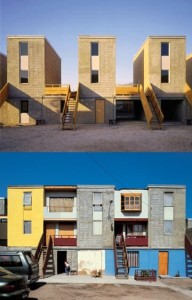When dealing the crisis of poverty, most organizations and governments follow the prototype of social expanse on low-income families. However in the free market in capitalism system, it is hard and takes more effort for these “charities” to survive with more expanse than income. As Yunus mentioned in the interview “a market must be developed as a self-correcting system”, social conscience practices need work as a sustainable system that generate profit in the process of helping the poor and keep the organization survive independently. Both Grameen’s microcredit system and Elemental’s practices are based on the philosophy of creating wealth and helping the poor at the same time.
It is Yunus and Aravena’s trust on the ability and the contribution of local dwellers and the poor that makes their practices so successful. When talking about the inspiration of his belief in social enterprise, Yunus thinks that it the village women who “struggle daily for dignity and to create a good life for themselves and their families” (Dr Toh Han Chong, 5). The creativity and hardworking of the poor give passion for these social enterprise to invest and provide opportunity for poor people. Yunus believes that the reason for poverty is the lack of opportunity.
In order to help the poor, Grameen microcredit bank provides the low-income family with the opportunity to generate more income. And the regulating system with their outreach workers can make sure that the borrowers are using the loan for income generating purposes so that they will have ability to pay back to Grameen bank and have more money to support their families. Yunus extends this idea also to the Grameen Healthcare (GH) that they provide healthcare service first and the poor patients can pay for the service sometime in the future.
Aravena and Elemental uses similar philosophy in their architectural practices. The completion of buildings is not only architects’ job but also based on the dwellers themselves. Elemental provides highly designed architectural framework and leave the space for local dweller to add or change the building depending on their needs. Social enterprises like Elemental “empower local builders by giving them the knowledge that allows them to take these same innovations and apply them themselves” (Aravena, 35). This kind of practices saves the time and cost that are the most important in social housing projects. Each owner builds the second half the house and is responsible for “customizing the final solution” (Aravena, 35) in Elemental’s first practice in Iquique project in 2003. The value of houses increases because of the contribution of dwellers.

Also, the cooperation between institutions, enterprises and governments makes social investment easier in practice. “This unusual combination of academic excellence, corporate vision and entrepreneurship has been instrumental in enabling Elemental to expand its scope in the city” (Aravena, 32). Similar to Grameen, they create a health network that combine university and hospital center “hub” including a nursing college to serve for clients.
The sustainability should be the focus for more social organization and enterprises. Aravena and Yunus’s success give us good examples of social investment rather than only social expanse in social practices.
1. Dr Toh Han Chong, Interview with Professor Muhammad Yunus, SMA News, Volume 40 No. 12 December 2008.
2. Alejandro Aravena, ‘Elemental: A Do Tank”, Havard Design Magazine 21, Fall/Winter 2004/5.